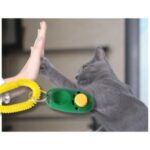“Doc, he nearly pulls my arm off every time I walk him…”

Does your dog turn a relaxing walk into a stage of the Iditarod sled-dog race?
You are not alone! It is one of the most common concerns of dog owners.
The goal can be teaching a dog to perform the more formal “heel”, where the dog is only on one side and the shoulder is in line with the person’s leg. An alternative method is to teach loose-leash walking, where the dog can walk and sniff where it likes, but is not pulling on the leash. I will focus more on the loose leash walking as a way to get more enjoyment for pet and walker.
First, if you can, let your dog run and let off a little steam before attempting a calm walk or a training session:
Choose the right equipment:
- Regular 4-6 foot leash
- Avoid retractable leashes
- Consider a harness or head halter. Great examples are:
- Freedom Harness by 2Hounds Design,
- Easy Walk Harness by Pet Safe,
- Gentle Leader head collar
- Halti head collar
- Small but high value treat for positive reinforcement
Set the stage:
- Exercise your pet first for a few minutes to release some energy
- Train with treats when your dog is hungry
- Start in an area with few distractions, like your backyard
- Only train for a few minutes at a time (10-15) to start
- Practice every day
- Be patient and consistent
Keep it PAW-sitive! 🐾
Reward the behavior you want by offering a small treat and praise when your dog is walking without pulling. This form of positive reinforcement encourages the pet to repeat the behavior that won them the reward.
Positive reinforcement is the cornerstone of training pets and works better than punishing unwanted behavior. Harsh punishment tends to increase fear and anxiety and doesn’t actually show the pet what you want.

Stop and go:
- the owner stops walking as soon as the dog pulls, and will not move until the leash is slack
- combine with praise and treats when the dog is walking with a loose leash
Change direction:
- When your dog starts pulling, abruptly change direction
- This teaches your pet to pay attention to you and stay close
- Reward attention and a slack leash with a treat or praise
Kick it up a notch:
Once you have a few training sessions under your belt and your pup is improving, you can start to move forward.
- Gradually increase length of training sessions
- Visit areas with more distractions, like parks
- Try a clicker at the same time as a treat to reinforce the reward
- Gradually increase the duration of good behavior before the reward is given
- Slowly phase out the reward, giving it intermittently, while using praise
- Add voice commands like “heel’ or “walk nice” when starting out
Bonus tip:
Teach focus and attention to improve any type of training:





